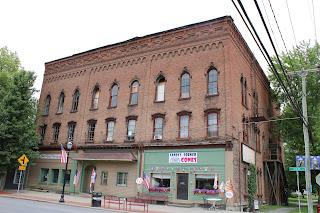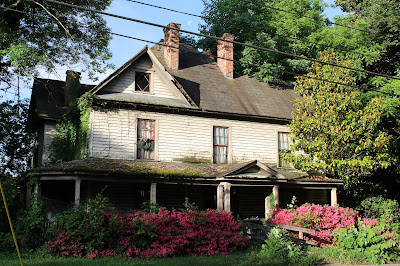Located in central Statesboro, Georgia, the Blind Willie
McTell Trail traverses 1.1 miles through residential and commercial districts
of the seat of Bulloch County. Named after a relatively obscure blues singer
who found fame after his death in 1959, the trail honors a history, a person,
and an art form that would not have received such accolades when McTell was
alive. From the baseball and softball diamonds of the county parks, the trail
makes its way north toward the downtown commercial district, paralleling where
the Savannah & Statesboro railway line once was. Along the way it passes
warehouses that once stored cotton as well as abandoned railroad tracks and rights-of-way
that transported it around the world. It passes a relatively large animal
hospital where each time I walked past I watch anxious humans wait patiently
with their feline and canine friends. A little further along, a dog park was a
point of refuge for many happier dogs. The trail ends at Main Street, near the
Eagle Creek Brewery and the Sugar Magnolia Bakery and Café.
 |
A statue of Blind Willie McTell outside the Visitor's
Bureau in Statesboro |
My original plan for exploring and walking the trail was
to occur in November. But a surge in Covid cases postponed it to March. But even
then, the virus continued to rage and spread, making travel unsafe. After I
received my second vaccine in April, it was late May before we made our way to
Statesboro. We planned two nights in Statesboro. As soon as we arrived, I was
anxious to get to the trail. My first walk was hot, it was 92°
and I had the trail to myself. A reasonably paced walked brought me to Sugar
Magnolia Café after about twenty minutes to enjoy an iced tea. Over the next
two days, I would walk the trail twice more, out and back. There is precious
little information about McTell’s life, and this is reflected on the trail. Other
than a plaque at both terminuses, the signs along the way emphasize the
benefits of nature and greenspace to those who pass by rather than recount McTell’s
accomplishments.
Just a few steps from the trail’s downtown terminus on
Main Street is city hall that was formerly the Jaeckel Hotel. The hotel once
served as a business and social hub for the city. By several accounts, Blind
Willie would play for the businessmen on the porch of the hotel during tobacco
season. He was popular and the hotel’s guest were anxious to hear him play. As
I walked through the downtown, I imagined Willie walking the streets he knew so
well and thought about what he would have experienced. There is evidence to
suggest that he and his mother lived on a house on East Cherry Street near
where the trail is today. He claimed that he knew every step in the city and,
although born in Thomson, some ninety miles north, McTell considered Statesboro
home, and joked that he did not want any new construction because he would be
lost. Life as an itinerant black musician could not have been easy. When McTell
was a child, a statue to confederate soldiers was erected on the grounds of the
county courthouse downtown in 1909. Five years before, Georgia led all states
in the country in the number lynchings, including a particular brutal incident
in Statesboro.
 |
| The former Jaeckel Hotel, now city hall |
Despite the genre of the blues having a reputation,
McTell’s songs tend to be upbeat and gregarious. His particular sub-genre,
Piedmont blues, is different from the more famous variant, Delta blues whose
legendary, shadowy figure is Robert Johnson. McTell’s considerable musical
talents, particularly his skill on a 12-string guitar, brought him to the
attention of many. Perhaps the itinerant live of a blues singer is best
reflected in a trail. In McTell’s most famous song, “Statesboro
Blues,” famously covered by Taj Mahal and the Almond Brothers, he sings,
“hand me my travelin’ shoes.” In fact, many of his songs are about travel,
something that he knew quite a bit about. In “Travelin’
Blues,” he tells the story, one has to believe autobiographically, of
trying to hitch a ride on a train as a hobo. Throughout the song, despite his
plight as a poor traveler, the narrator recounts the kindness of strangers to
offer him food and help him on his journey.
In the 1920s there was a burgeoning recording industry in
Atlanta, where McTell recorded at least eighty sides. The Great Depression put
an end to the recording industry in the city, and he never found commercial
recording success in his lifetime. He complained that he never benefited from a
recording session, which is probably true. McTell died in 1959, after suffering
from diabetes and alcoholism in his later years. The fame that was elusive in
his life grew as blues aficionados discovered his music and his hometown
recognized his greatness. Success came too late for him to enjoy it, but we are
lucky to have many of his recordings available if not a better understanding of
the man.































